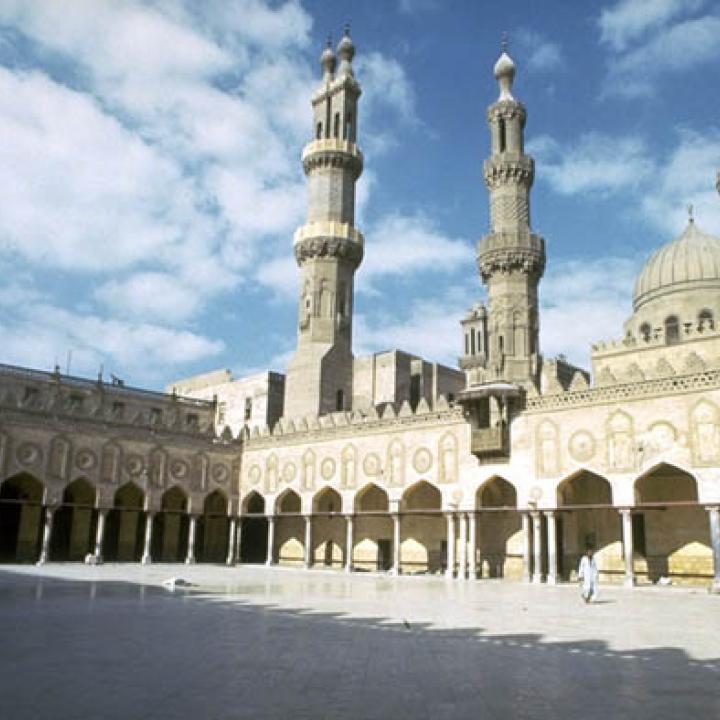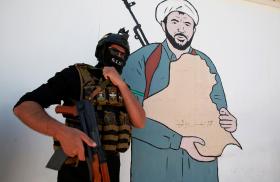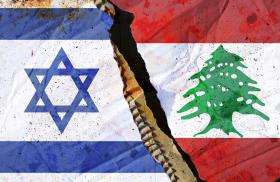
- Policy Analysis
- PolicyWatch 3098
After the Islamic State, Renewed Urgency for Religious Reform

The IS “caliphate” may have perished, but its ideology and capacity for future outbreaks will persist unless more vigorous reforms are instituted.
The recent declaration of the Islamic State (IS) territorial defeat in Syria has refocused the debate on how to achieve an enduring peace based on successful counterextremism initiatives. This raises a crucial question: who may legitimately be tasked with countering the religious appeal of jihadism in the region?
On April 2, Sheikh Ahmed al-Tayeb, the Grand Imam of Al-Azhar, met with United Nations secretary-general Antonio Guterres in Cairo, where both officials reiterated their commitment to achieving an enduring global peace, countering extremism, and curtailing hate speech. This comes on the heels of the historic February visit by Pope Francis to the United Arab Emirates, where he and Tayeb signed the “Declaration of Human Fraternity,” suggesting that the widely renowned Egyptian-based religious institution perceives itself as a moderating force capable of taking the lead in countering extremism among the world’s Muslim communities. The declaration emphasized, among other things, the importance of fighting extremism globally, while promoting interfaith tolerance as a central component for achieving this goal.
While these are welcome advances, the assumption that religious extremism is best countered through exercising tolerance toward the non-Muslim “other” and “awakening religious awareness”—two central themes within the declaration—fails to take into account two important considerations particular to the region. First, institutions like Al-Azhar that are presumably tasked with “awakening religious awareness” are themselves under continuing pressure to religiously reform. Second, violent extremism in the region is as much an outgrowth of a lack of intra-faith fraternity as it is a product of general intolerance toward non-Muslims.
LIMITATIONS OF CURRENT RELIGIOUS INSTITUTIONS
Al-Azhar has been at the center of heated debates in Egypt regarding its inadequacy in countering extremism. Among other things, the institution has increasingly become dominated by Muslim Brotherhood and Wahhabist elements, reinforcing an internal conservative block that has routinely resisted reform attempts.
The institution’s university curricula have similarly come under fire for pushing orthodox sharia teachings that, for one thing, perpetuate highly discriminatory pre-modern social views that demonize non-Muslims. Even though Egyptian president Abdul Fattah al-Sisi has placed significant pressure on Al-Azhar to revise its narratives, the institution must still do more to effectively combat religious fundamentalism. In 2017, for instance, Al-Azhar’s Council of Senior Scholars voted to reject requests to change patriarchal divorce laws—namely, the right whereby only men can divorce their wives without the need of a court or the wife’s consent—arguing that the current law reflects the “undisputed practice of the Prophet Muhammad (peace be upon him).”
Al-Azhar’s seeming inability or unwillingness to play a larger role stems in part from the near-sacrosanct status of the Islamic traditions (hadith). The analyses of these by various jurisprudential camps form the basis of a large corpus of legal rulings. Customarily, interpretations of hadith deemed authentic demand unwavering fidelity to the school of thought behind the interpretation. This, in turn, restricts Islamic scholars’ creative capacities to substantially push for innovation or reform.
As a result, the inconvenient fact that hadith studies around the world could use significant reforms gets ignored entirely. And sometimes, the applicability of the hadith to current affairs is interpreted away, such as when the signatories of the 2014 letter to IS leader Abu Bakr al-Baghdadi attempted to discredit the group’s jihad by arguing that the group had failed to enact the tenets of true jihad, instead of challenging sharia traditions that drive the violence carried out by such groups. By failing to put together a more robust theological counterargument for why these rules should no longer apply, institutions like Al-Azhar continue to religiously condone discriminatory discourse and practice toward Muslims and non-Muslims alike. The former is most evident in the Sunni-Shia doctrinal divide that underpins so much conflict in the Middle East today, and which constitutes a core theme in jihadist propaganda.
A MISSING INTRA-FAITH MUSLIM FRATERNITY
Currently, the very same Sunni-majority states that seek to religiously reform and normalize interfaith relations (e.g., Saudi Arabia) do not confront the inherent demonization of minority Muslim sects considered heretical by mainstream Sunni doctrines—Shia Islam being among the most prominent. The notable absence of a discussion on the effects of Muslim sectarianism and its contribution to violent extremism on both sides of the divide likely reflects in part the strong factional tendencies within the prevalent Sunni schools of thought.
On another front, repeated constructive attempts to address problematic religious sources linked to violence and extremism have faced the strongest resistance from religious institutions like Al-Azhar. In one alarming case, Egyptian reformist Islam al-Beheiry was publicly apostatized by former acting Al-Azhar director Ahmed Hosni Taha for suggesting the possibility of human error in the verbal transmission of hadith throughout the earlier generations of Islam. Even more shocking was Taha’s simultaneous refusal to excommunicate IS fighters on the grounds that they uttered the Islamic testimony of faith or Shahada, prompting a television host to ask, “Well, does Beheiry not also utter the Shahada?” While Taha has since been removed from his post and reassigned within the organization, dissenting views and opinions from outside the religious establishment are rarely tolerated, and often actively combated.
This is not lost on transnational jihadists, whose unchecked violence and tactical religious transgressions naturally thrive amid this stagnant set of legal traditions. Religious institutions seek to maintain their control over these outdated blueprints for state and society, since their institutional power and authority derive largely from a continued monopoly over the interpretation of religious law. This dynamic translates to an ineffective response to Islamists, whose worldview is guided by some of the same pre-modern notions of governance found in the sharia. But it also helps explain the general trend of unwitting intellectual collaboration between the Muslim clergy and political Islamists against a Muslim intelligentsia with whom they disagree, yet whose ideas present significant potential for developing effective counternarratives to violent extremism.
CONCLUSIONS: A TWO-PRONGED APPROACH TO RELIGIOUS REFORM
Inadequate attempts to address doctrinal schisms within Islam, and the resultant intolerance toward outside voices advocating change, are among the prime contributors to religious extremism in Arab and Muslim-majority countries today. Notwithstanding the persistent deficit in human rights advances in most Middle East countries—itself a significant contributor to extremism—a two-pronged approach could move Egypt and neighboring countries interested in countering fundamentalism to further moderate religious thought:
1. Supporting emerging voices of religious moderation within civil society. Fostering inter- and intra-faith tolerance depends as much on official religious leadership as it does on an individual’s ability to reflect critically on religion. Despite the continued reluctance of institutions like Al-Azhar to initiate meaningful reforms, civil society has helped fill the gap by, for instance, putting out increasing numbers of TV shows dedicated to thoughtfully critiquing religion and making the case for reform. Prominent examples in Egypt include shows by the abovementioned Beheiry—such as al-Khareeta (The Map) and al-Bosla (The Compass)—and Ibrahim Eissa, one of Egypt’s most prominent TV show hosts and journalists, in Mokhtalaf Aleih (Debatable). Notably, many of these shows are being produced from within Egypt, arguably a result of Sisi’s repeated push for renewed religious discourse both at home and abroad. This trend is worth protecting and expanding, and promotes a grassroots approach bound to enjoy more credibility than enforced top-down campaigns.
2. Maintaining public pressure on the religious establishment to reform. There is growing popular appetite for a more aggressive official response to religious extremism. On the Egyptian scene, increased pressure for reform has lately encouraged Al-Azhar officials to take a more visible stand on issues such as women’s rights. For instance, in a talk given by Sheikh Tayeb on Egyptian Mother’s Day, the scholar made a strong argument against polygamy. On the institutional level, Al-Azhar, guided by an independent panel of Egyptian and foreign experts, has adopted curricular amendments aiming to balance the religious narrative with a cultural and historical perspective on the country’s heritage. While secularizing curricula does not immediately solve the deeper theological issues raised here, students at the institution will at least receive some protection from more-divisive educational content until a holistic rethinking of religious sciences is initiated.
Dina Al Raffie is an adjunct assistant professor at Saint Vincent College in Latrobe, Pennsylvania, and a returning adjunct professor with the George C. Marshall Center’s Program on Terrorism and Security Studies. All views expressed in this article are her own.

